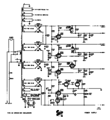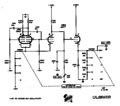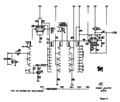315: Difference between revisions
No edit summary |
No edit summary |
||
| Line 10: | Line 10: | ||
|designers=Frank Hood;Dick Ropiequet;John Kobbe;Ted Goodfellow;Jim Morrow | |designers=Frank Hood;Dick Ropiequet;John Kobbe;Ted Goodfellow;Jim Morrow | ||
|manuals= | |manuals= | ||
'''315''' | |||
* [[Media:Tek_315.pdf|Tektronix 315 Manual]] | * [[Media:Tek_315.pdf|Tektronix 315 Manual]] | ||
'''315D''' | |||
* [ | * [[Media:IM-315D.pdf|Tektronix 315D manual]] | ||
* [[Media:tek_315d_fcp.pdf|Tektronix 315D factory calibration procedure]] (OCR) | * [[Media:tek_315d_fcp.pdf|Tektronix 315D factory calibration procedure]] (OCR) | ||
* [[Media:tek_315d_instruction_manual.pdf|Tektronix 315D manual]] (bad-OCR) | * [[Media:tek_315d_instruction_manual.pdf|Tektronix 315D manual]] (bad-OCR) | ||
* [[Media:Tek 315D irb.pdf|Tektronix 315D Instrument Reference Book]] (OCR) | * [[Media:Tek 315D irb.pdf|Tektronix 315D Instrument Reference Book]] (OCR) | ||
* [[Media:315_Mods.pdf|Tektronix 315D Modification Summary]] | * [[Media:315_Mods.pdf|Tektronix 315D Modification Summary]] | ||
<!-- | |||
* [https://w140.com/tek_fcp/tek_type_315_factory_cal_proc.pdf Tektronix 315D factory calibration procedure] | |||
--> | |||
}} | }} | ||
The '''Tektronix Type 315 and 315D''' are single-channel oscilloscopes [[introduced in 1952|introduced in September 1952]]. | The '''Tektronix Type 315 and 315D''' are single-channel oscilloscopes [[introduced in 1952|introduced in September 1952]]. | ||
| Line 104: | Line 108: | ||
</gallery> | </gallery> | ||
==Components== | |||
{{Parts|315}} | {{Parts|315}} | ||
[[Category:Monolithic tube scopes]] | [[Category:Monolithic tube scopes]] | ||
[[Category:Introduced in 1952]] | [[Category:Introduced in 1952]] | ||
Latest revision as of 12:00, 21 September 2023
The Tektronix Type 315 and 315D are single-channel oscilloscopes introduced in September 1952. They use 3WP2 3-inch CRTs. Later instruments use the Tek-made T3100-xx CRT.
Historic Context
Tektronix engineer Frank Hood recollects:
We started to move into the new Sunset plant in June of 1951. In the same year I started the design work on our first compact scope, the Type 315. This instrument had several innovative features. One was a sweep circuit designed by Dick Ropiequet which was several times more stable and accurate then any other then in use. With this circuit, the actual time of the sweep could be calibrated with such accuracy that we decided to start calling it a “TIME BASE”. The vertical amplifier was also more stable and accurate. A man in our test department, John Kobbe, suggested a direct coupled unblanking circuit. Another employee, Ted Goodfellow, a musician with ceramics as a hobby, suggested making a ceramic strip with silvered notches to act as insulator and support for the components. This smaller scope had less space on the front panel for the necessary controls. A Machinist, Jim Morrow, suggested combining some of the controls, by making them co-axial (that is, a shaft within a shaft and separate knobs.) We tried to purchase such controls but could find no one interesting in making them, so Jim machined sample controls. He even machined the dies to produce our own plastic knobs. All these suggestions were incorporated in the 315. Several patents were granted, which later led to a patent infringement suit which we brought against the Government (we eventually won the lawsuit)."
Key Specifications
| Bandwidth | DC to 5 MHz |
|---|
Internals
Case Design
The 315 is mechanically similar to early 500-series monolithic scopes such as the 511A. The scope slides out of the case instead of having removable side covers as were used in the later 53x and 54x, and the 55x, 56x, 57x, and 58x designs.
3" CRT
The move to use a 3” CRT rather than a 5” was to produce a “portable” oscilloscope, which the 315-D was promoted as. With dimensions considerably smaller than the 5” models and only weighing a modest 36 pounds, it offers a lot of performance in a small package. In 1956, Tek introduced a rack mount version, the 315R. One has to wonder what the benefit of a 3" screen is when it was packaged as a rack sized instrument. Instruments originally used a purchased 3WP_ CRT. A mod was published in 1964 substituting the Tek-made T3100 CRT, part numbers 154-0362-00 through 154-0366-00, depending on the phosphor.
Delay Line
As with earlier 5” Tektronix scopes, the “D” suffix indicates the inclusion of a delay line in the vertical signal path. The delay line resides between the pre-amplifier, where the trigger signal is picked off and the final vertical amplifier. The delay line allows time for the sweep to start and the unblanking to turn the trace on slightly before the trace is deflected, so the user can see all of the rising edge of the signal which triggered the scope. The original 511, Tek’s first scope sold, did not have a delay line. It was added with a few other circuit enhancements to become the 511-AD model.
Pricing
The delay line was offered as a “delete” option on early scopes, with the version without the delay line selling for $50 less. Apparently most customers ordered the delay line versions, and the 315 was the last scope introduced with the D suffix. Even so, the 1953 catalog, which was the first the 315-D appeared in, did not list the version without the delay line. It is quite possible that no plain 315 models were ever sold.
Links
Pictures
315 D
-
-
Front view
-
Right view
-
Right internal
-
Top internal
-
Left internal
-
Bottom internal
-
Rear view
-
Low-voltage power supply
-
Time base
-
Time base range switch
-
Preamp
-
Calibrator
-
Trigger selector and shaper
-
Vertical amplifier
-
CRT circuit
315 R
-
315 R
-
315 R
-
315 R
-
315 R
-
315 R
-
Catalog photo of 315R
-
Gray 315R
-
Gray 315R
-
Gray 315R
-
Gray 315R
-
Gray 315R
-
Gray 315R
-
Gray 315R
-
Gray 315R
-
Gray 315R
-
Gray 315R
-
Gray 315R
-
Gray 315R
Components
Some Parts Used in the 315
| Part | Part Number(s) | Class | Description | Used in |
|---|---|---|---|---|
| 12AT7 | 154-0039-00 | Vacuum Tube (Dual Triode) | dual high-gain triode | 161 • 180 • 310 • 310A • 315 • 316 • 360 • 502 • 502A • 511A • 512 • 513 • 513D • 514 • 514AD • 514D • 516 • 524 • 529 • RM529 • 544 • 546 • 547 • 556 • 565 • 570 • 3A2 • 75 • 3A75 • 1M1 • A • B • C • G • H • K • L • ML • M • N • K • R • S • Z • Keithley 610B |
| 3WP | 154-0059-00 | CRT | series of flat-faced 3" mono-accelerator CRTs | 315 • 310 • 360 • Telequipment S31 |
| 6AK6 | 154-0015-00 | Vacuum Tube (Pentode) | power pentode | 315 |
| 6AL5 | 154-016 • 154-0016-00 • 154-0038-00 | Vacuum Tube (Dual Diode) | high-perveance dual diode | 163 • 181 • 190 • 1M1 • 310 • 310A • 315 • 316 • 317 • 3B1 • 3B1S • 3B2 • 3B3 • 3B5 • 502 • 502A • 503 • 511 • 511A • 512 • 516 • 517 • 517A • 524 • 526 • 535 • 535A • 545 • 545A • 549 • 551 • 565 • 570 • 581 • 581A • 585 • 585A • C • T • Telequipment D52 • Telequipment D56 • Telequipment S52 |
| 6BQ7 | Vacuum Tube (Dual Triode) | dual triode | 315 | |
| 6BQ7A | 154-028 • 154-0028-00 • 157-0022-00 • 157-0003-00 | Vacuum Tube (Dual Triode) | dual triode | 107 • 163 • 181 • 310 • 315 • 316 • 360 • 524 • 531 • 532 • 535 • 536 • 541 • 545 • 570 • T |
| 6U8 | 154-0033-00 | Vacuum Tube (Triode/Pentode) | triode-pentode combo | 130 • 160 • 163 • 310 • 315 • 316 • 524 • 535 • 545 • T |
| T3100 | 154-0362-00 • 154-0363-00 • 154-0364-00 • 154-0365-00 • 154-0366-00 • 154-0058-01 • 154-0059-01 • 154-0060-01 • 154-0061-01 | CRT | 3" CRT | 310 • 310A • 315 • 360 |


































